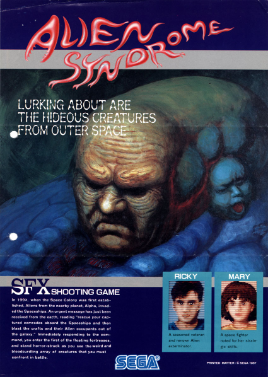Top Qs
Timeline
Chat
Perspective
Alien Syndrome
1987 video game From Wikipedia, the free encyclopedia
Remove ads
Alien Syndrome (エイリアンシンドローム, Eirian Shindorōmu) is a 1987 run and gun video game developed and published by Sega for arcades. The game utilizes a side-scrolling feature that allows the player to take control of either a male (Ricky) or female (Mary) soldier whilst hunting aliens and saving hostages before they run out of time.
This article has multiple issues. Please help improve it or discuss these issues on the talk page. (Learn how and when to remove these messages)
|
Alien Syndrome was released to commercial success and positive reviews, with praise towards its gameplay, character designs, sound design and horror themes. It was ported to various home computers and consoles, including Sega's own Master System, becoming one of the best-selling titles for that console. It was included as a bonus title in the 2009 compilation Sonic's Ultimate Genesis Collection. A sequel of the same name was released in 2007 to a mostly negative response from critics.
Remove ads
Gameplay

Two players control two soldiers, named Ricky and Mary, who fight through large eight-way scrolling levels while rescuing their comrades that are being held by aliens. At the start of each level, a time bomb is set onboard the infested ship and the players must complete their task before it runs out which will result in the ship being destroyed. After they have rescued a certain number of hostages, the exit opens and they can pass through it in order to fight the end-of-level guardian. If the guardian is defeated before the time runs out, the players are then able to move onto the next stage. Once all seven levels are completed, the game starts over with more aggressive aliens, and less time on the clock.
Remove ads
Ports
In 1988, the game was ported to the Master System, MSX, Amiga, Atari ST, Amstrad CPC, Commodore 64, and Famicom/Nintendo Entertainment System (published in North America by Tengen without a Nintendo license). Later, the game was ported to the ZX Spectrum (1989), Game Gear (1992), and X68000 (1992).
Reception
Reception
In Japan, Game Machine listed Alien Syndrome as the third most successful table arcade unit of April 1987.[18] The original arcade version of the game was reviewed in the July 1987 issue of Computer and Video Games, where Clare Edgeley described it as "one of the most gripping games" she "played in months", praising the Aliens-like horror atmosphere, chilling sounds, special effects, graphics and gameplay. She stated it was "the first time the atmosphere and sheer addictiveness of a shoot 'em up has transported me to another planet," and concluded that it "is fantastic".[19]
The Master System version of the game was reviewed in Console XS magazine, which gave it an 85% score.[15] It was reviewed in 1989 in Dragon, which rated it two out of five stars.[13]
Legacy
The game was also converted to polygonal graphics for the PlayStation 2 as part of the Sega Ages re-release program and included in the US version of the Sega Classics Collection (it was removed from the European version to receive a lower age certificate). This version has updated controls, adding the use of both analog sticks, similar to that seen in Sheriff, Robotron: 2084, and Smash TV. The original arcade game was also included as an unlockable in Sonic's Ultimate Genesis Collection.
A sequel of the same name was released for Wii and PlayStation Portable in July 2007.
Remove ads
Notes
- Master System and NES versions developed by Sanritsu; Amiga, Atari ST, Commodore 64 and ZX Spectrum versions developed by Softek International; Amstrad CPC version developed by Animagic; MSX version developed by Xortrapa Soft; Game Gear version developed by SIMS; X68000 version developed by Dempa Micomsoft.
References
External links
Wikiwand - on
Seamless Wikipedia browsing. On steroids.
Remove ads

